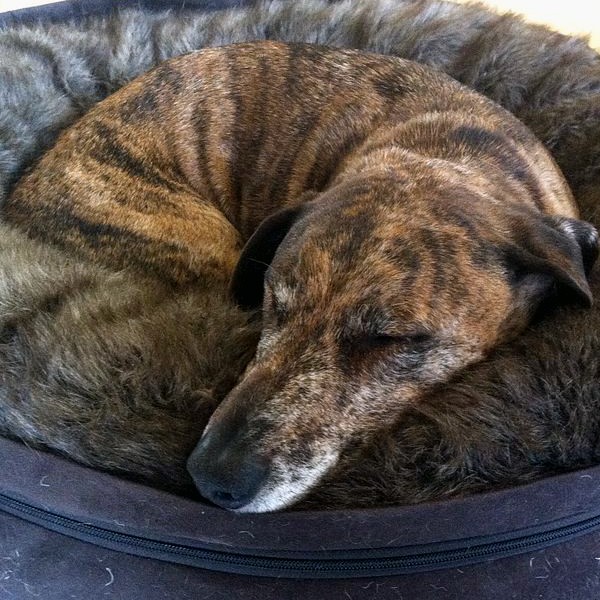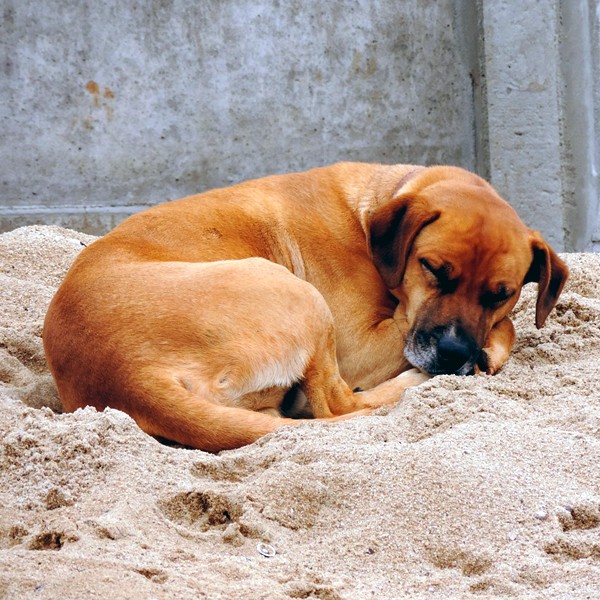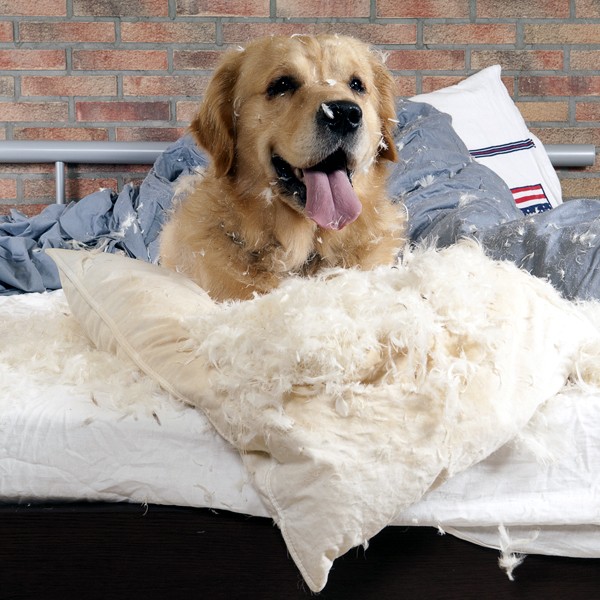Why Do Dogs Dig in Their Beds?
Recently, I found a thick throw rug at a thrift store. I thought it looked like a warm bit of bedding that my dog could use for her nesting. I draped it over her two other blankets and carefully tucked it to conform to the shape of her bed. Next time I went to visit her, she’d removed the new cover, dragged it halfway across the room, and left it there. I found her curled up, sleeping on her older quilts.

Sleep preparation is more involved than a dog lying down. (Photography via Wikimedia Commons)
I don’t know about you, but I have any number of pre-sleep rituals. Many of them have become so habitual that they now border on instinct. For instance, no matter the temperature, I have sheets and blankets that have to be in a certain layer order. If I happen to be away from home, I always wake up earlier than I do when I’m in my own bed. Comfort makes a difference to my sleeping ability and quality. Do our dogs observe similar bedtime rituals? Let’s answer some questions about dog nesting behavior, including:
- Why do dogs circle before lying down?
- Why do dogs scratch the floor?
- Why do dogs dig in bed?
Why do dogs walk in circles before lying down?
Sometimes, her turning radius is as tight as her 3-by 2-foot dog bed in winter, and others, as broad as a spot against the fence outside in the summertime. Regardless what time of year, it never ceases to fascinate me when I watch my dog circumnavigate her chosen sleeping spot. What motivates her to spin about before coming to rest? Like my own idiosyncratic pre-sleep rituals, walking in circles establishes a dog’s comfort in a few different ways.
Long before dogs could nestle in our beds or had proper dog beds of their own, circling was a means of establishing both safety and comfort. In nature, circling a chosen spot is one method dogs employ to ensure the exclusivity of their sleeping place. Trampling about on high grasses or leaves creates sufficient disturbance to drive out any creatures that may be hiding there, such as the odd snake, rodent, or insect.
Circling is also a security measure. A dog’s paw pads have a couple of little-known or heralded features. They are one of the few surface areas on a dog’s body that have sweat glands. More germane to the matter at hand, dog paws also feature scent glands. Taking a few turns around a favored sleeping area — be it a spot of earth or a proper bed — effectively marks it with a dog’s scent. If you’ve ever seen an old Western film where a group of pioneers “circles the wagons,” dog circling may perform a similar defensive function. Doing so allows a dog to survey his spot before settling in.
Why do dogs scratch the floor?
This question has a number of variants; one of the most popular and confounding to owners of indoor dogs is, “Why do dogs scratch the carpet?” It’s a question that’s perplexed humans forever. The dog is inside, after all! The surface she is scratching at, whether it’s carpet, tile, or hardwood, is not a malleable material. We get frustrated because the carpet gets torn or mangled and those other surfaces may need polishing or buffing, or worse yet, retain claw marks.
Cat owners buy their pets cat trees and scratching posts, but few such provisions exist for our puppies and dogs. Some breeds or types of dogs, terriers and hounds among them, are accustomed to digging and burrowing, whether for prey, security, or scent discovery. If your dog is the burrowing sort, but spends the vast majority of her time alone and indoors, she is being denied part of her fundamental identity. Giving her more outdoor time, in the yard or at the dog park, may help her fulfill a basic need.

Marking and comfort are two reasons that dogs dig and scratch their beds. (Photography via Pixabay)
Dogs who scratch at carpet may do so as part of sleep preparation. Dogs do not care about the aesthetic integrity of your home furnishings. As with turning or circling, scratching serves a number of practical purposes, at least one of which is sleep related. It may be part of the instinctive bedtime ritual, associated with her favored resting spot. Circling several times imbues a place with the dog’s scent. Scratching may serve a similar function, physically marking and claiming a spot. Dogs are just as much creatures of habit as we are. I’ve seen my own dogs rehearse the entire pattern: scratch, circle, and rest.
Why do dogs dig at their beds?
Digging, like scratching, is another pre-sleep habit that dog owners notice. This is another habit or behavior that cat owners are accustomed to, even if they’re just as clueless as to the rationale behind it. The feline equivalent of digging in bed is kneading. Just as dogs scratch and dig to establish a comfort zone, heedless of the effect it will have on your couch, bed, or carpet, cats knead at their resting spots, even if it means puncturing your leg in the process.
As much as the amateur horticulturists among us tut and cluck about it, a dog digging up the garden is understandable. After all, the earth is pliable, and a dog can dig until she’s satisfied. Surely, dogs can differentiate between the ground outside and your favorite comforter, your bed, or the floor of her own crate. The material makeup of the dog’s bed is of less consequence than the action.

Circling, scratching and digging are all common dog nesting behaviors. (Photography via Shutterstock)
Where sleep is concerned, digging into bed can be habitual and instinctive, or related to temperature. In nature, digging at beds serves as a method of extreme temperature control. Because dogs have limited sweat glands, when it is very hot outside, dogs may dig nests, exposing a greater surface area of their bodies to cool earth. In cold weather, curling up in a self-fashioned pit helps to concentrate available body heat.
Does your dog circle, scratch or dig on his bed or near his bed?
After doing the research for this essay, I realized why my own dog ditched her new blanket in favor of her ratty and well-worn nesting materials. It’s precisely because the old ones are ratty and well-worn. I’ve seen her circle over them and trample them underfoot countless times. I’ve seen her scratch at them with her claws and dig into them repeatedly.
Effectively, she’s marked these things enough to have established them as her bedding. My disappointment at my dog dragging the new, warm blanket is not her problem. It is a foreign element that intruded itself upon her comfort zone. Only after she’s rent that new one with her mouth, torn at it with her claws, and endowed it with her own peculiar smells will it be fit for use.
Read Next: Here’s Why Your Dog Always Wants to Sleep With You
